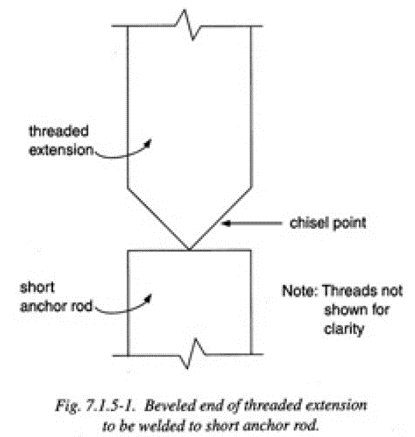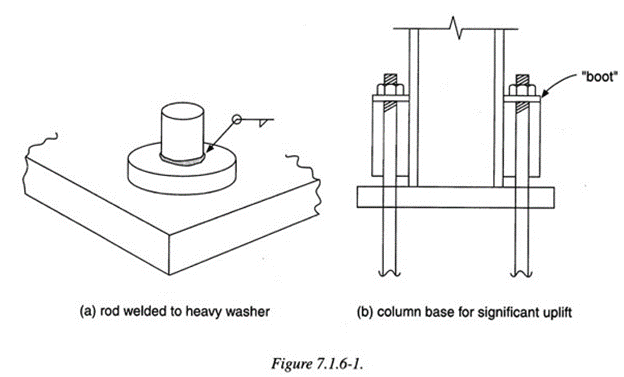Steel Solutions Center
7.1. Anchor Rods
7.1.1. Why has AISC initiated a change in nomenclature with the term anchor rod?
AISC has changed its terminology to anchor "rod" to eliminate confusion between structural bolting applications, such as those covered by the AISC and RCSC Specifications, and anchorage applications between steel members and concrete elements. This includes such issues as installed tension, slip resistance, and hole sizes, which do not apply in anchor-rod applications as they are covered for all-steel bolting applications. Anchor rods may be configured to provide anchorage into concrete by means of a head, threading with a nut on the end, a hook, or by swaging. The term anchor bolt, when used with ASTM A307 grade C, A325, or A490 material, however, only describes the first option for the following reasons:
- These specifications include heading requirements.
- ASTM A325 and A490 include defined threaded lengths.
- Bolts meeting these specifications are generally only available in lengths up to about 8 in., except by special order.
last modified 30 August 2002
7.1.2. To what material specifications are anchor rods ordered?
There are three basic alternatives:
- ASTM F1554 covers anchor rods in headed, threaded and nutted, and hooked configurations with three yield-strength levels: 36, 55, and 105 ksi. It is intended that this umbrella specification cover the full range of material needs for anchor rods, including galvanized applications.
- Headed anchor rods can also be obtained in ASTM A449 and A354 material.
- Threaded and nutted or hooked rods can be obtained to meet the following material specifications: ASTM A36, A572, A449, A354, A588, and A687.
- ASTM A193, Grade B7 is acceptable for 105 KSI.
last modified 1 January 2006
7.1.3. Are rolled and cut threads equally acceptable for anchor rods?
Yes. The use of either rolled, cut, or ground threads is permitted in ASTM F1554 Section 6.2. Rolled threads are formed by pressing threading dies into the shank to displace the surplus of the metal outward. The original rod diameter must be slightly less than the nominal diameter, although the root area will still be critical (see 6.11.1), unless the rod end is upset. The steel is cold-worked, compressing its grain and increasing the yield and tensile strength, generally from 10 to 30 percent. Cut threads are made with a thread-cutting die or by lathe cutting. The original rod diameter is approximately equal to the nominal diameter; again, the root area will be critical as is normal in design.
last modified 1 January 2006
7.1.4. Can the same nut be used on both cut and rolled threads?
Yes. Both rolled and cut threads are produced to meet the same threading specification.
last modified 30 August 2002
7.1.5. How can short anchor rods be extended above base plates when the nut threads will not be fully engaged?
 There are two common methods to extend misplaced anchor rods that are too short to fully engage the nut threads. With either method, it may be necessary to enlarge the base-plate holes, which can be done by flame-cutting.
There are two common methods to extend misplaced anchor rods that are too short to fully engage the nut threads. With either method, it may be necessary to enlarge the base-plate holes, which can be done by flame-cutting.
In the first method, a thin-walled threaded coupler with adequate strength for the application is used to attach a threaded extension. It may be necessary to remove concrete near the top of the foundation to permit the installation of the coupler.
In the second method, a threaded extension is welded to the top of the existing rod. The threaded extension is prepared for welding by beveling the contact end to a chisel point as illustrated in Figure 7.1.5-1 and is subsequently welded using suitable electrode material. The surface of this welded transition is typically non-uniform and may necessitate the use of plate washers of sufficient quantity to allow free rotation of the nut. This method, which requires welding, may be unsuitable for heat-treated anchor rod material, such as ASTM A449 or ASTM F1554 GR 105.
Note that plug-welding the partially engaged nut to the anchor rod is not considered to be an effective means of attachment.
7.1.6. Can anchor rods be welded to a base plate?
Yes, if the rod material is weldable. Anchor rods are used primarily to provide a pre-positioned location upon which to erect the column and to provide stability during erection. They are also used in conjunction with the dead load of the structure to resist uplift forces. Subsequent welding of anchor rods to the base plate will not serve the first two purposes, but can be helpful in providing uplift resistance. Because the base-plate holes are oversized and the anchor rod is rarely centered in the hole, a heavy plate washer is required as illustrated in Figure 7.1.6-1(a); see also 7.2.4. The welding of rod to washer involves a fillet weld profile with a weld length that is equal to pi (3.14) times the rod diameter, which develops relatively little strength. Welding to the threaded portion of a rod is permissible. If larger uplift forces are present, an alternative column base detail, such as the boot in Figure 7.1.6-1(b) should be considered.

7.1.7. Do minimum edge distance requirements in Chapter J of the AISC Specification apply to holes in column base plates for anchor rods?
No, the provisions in Chapter J are for steel-to-steel joints, not steel-to-concrete joints with anchor rods. The base plates may be drilled or burned such that the drill does not drift as the hole is made. 1/4" is sufficient for this. Additionally, it should be noted that anchor rods are generally not designed to resist shear. The shear-friction method uses distortion of the base and uplift in the rod and may be adequate to resist the base shear. If uplift forces reduce the resistance due to friction or if horizontal forces are larger than can be addressed with the shear-friction method, the recommended procedure is to use a shear lug on the bottom of the base plate to transfer the horizontal forces to the foundation.
last modified on 1 January 2006
7.1.8. Are hooked anchor rods recommended when uplift or moment resistance is required at a column base plate?
No. Per ACI 318 Appendix D 5.3.5, the pullout strength of a hooked rod is determined based on the bearing component only, neglecting any frictional component because crushing inside the hook will greatly reduce the stiffness of the connection. This topic is discussed in further detail in each of the following AISC Design Guides:
Design Guide No. 1, Column Base Plates 2nd Edition
Design Guide No. 7, Industrial Buildings – Roofs to Column Anchorage 2nd Edition
Design Guide No. 10, Erection Bracing of Low-Rise Structural Steel Buildings.
last modified on 1 January 2006
